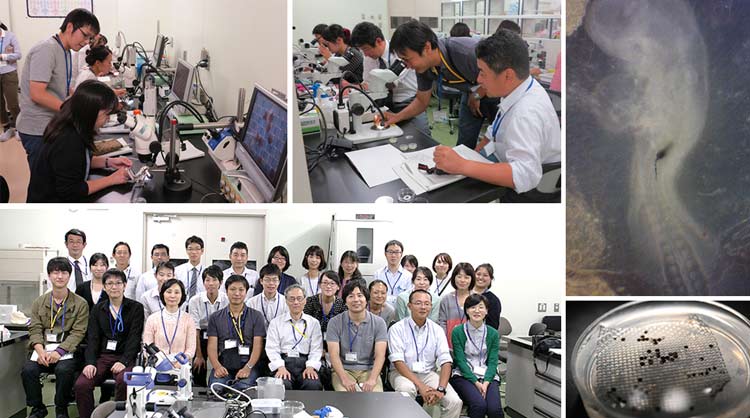
News and Announcements from the CDB
A developmental biology workshop for high school biology teachers was held on October 3 and 4 at the RIKEN Center for Developmental Biology (CDB). The two-day workshop, in its eighth year, was co-organized by RIKEN CDB and the Japanese Society of Developmental Biologists (JSDB) with the aim to help enrich biology education in the high school classroom. The theme of the workshop this year was the ‘organizer,’ a region of the early stage embryo that influences the development of other parts of the embryo, and the program included a talk on the recent developments in organizer-related research and a practical session with experiments using embryos of chicken and African clawed frogs (Xenopus).
The first day began with a lecture by Hidehiko Inomata, team leader of the Laboratory for Axial Pattern Dynamics, who explained how dorsal-ventral axis pattern is generated through the establishment of a concentration gradient within the embryo by so-called ‘dorsalizing’ morphogens secreted by the organizer region. He also introduced recent insights about the phenomenon of ‘scaling,’ in which body morphology can be maintained in different sized embryos by adjustments made to the morphogen gradients. The hypothesis that the different shapes of animals could be generated by perturbations to the scaling mechanisms captured the interest of many of the participants.

In the afternoon, the teachers visited Inomata’s laboratory, and under the guidance of research scientist Shinya Matsukawa and technical staff Kaori Niimi, who both work in Inomata’s laboratory, they took turns injecting mRNA into Xenopus embryos in an attempt to induce a secondary axis. This experiment allowed the participants to appreciate the role of the organizer, which was first discovered in the 1920s and has since been understood at the molecular level.
Following the lab visit, Sadao Yasugi, professor emeritus of Tokyo Metropolitan University and one of the organizers of the workshop, along with Kyoto Sangyo University’s Assistant Professor Yasuo Ishii and student Koya Yoshihi instructed the group on how to carry out a few experiments using chick embryos. In avian species, the Hensen’s node seen in early embryonic development functions similarly to the organizer in Xenopus, and the participants performed a transplantation experiment by excising the Hensen’s node from one embryo and transplanting it into another embryo to again try inducing a secondary axis. They also learned simple experiments that could be done in a classroom setting, such as culturing and observing early stage chicken embryos and tracking the migration of cells by labeling them with activated carbon.
The second day was spent observing the results of the experiments performed the day before. Most of the participants, unfortunately, did not see the induction of a secondary axis in their embryos, which drove home the message of how difficult it is to perform fundamental experiments in developmental biology. They also took an interest in the examining the morphological changes that occurred overnight in the embryo, and seeing where cells they had marked with activated carbon had migrated to. As in previous years, Yoshina Usui, a teacher at Hyogo Prefectural Suma Higashi High School, showed the participants how they could adapt some of the experiments carried out in the workshop for a high school science class using quail eggs.
In December, as an extension of this workshop, a few of the teachers who took part in the program will have the opportunity to bring their own students to the CDB and teach them to carry out similar experiments through a special hands-on tutorial for high school students.
| Related link | http://www.cdb.riken.jp/recurrent/2015 (in Japanese) |
|---|